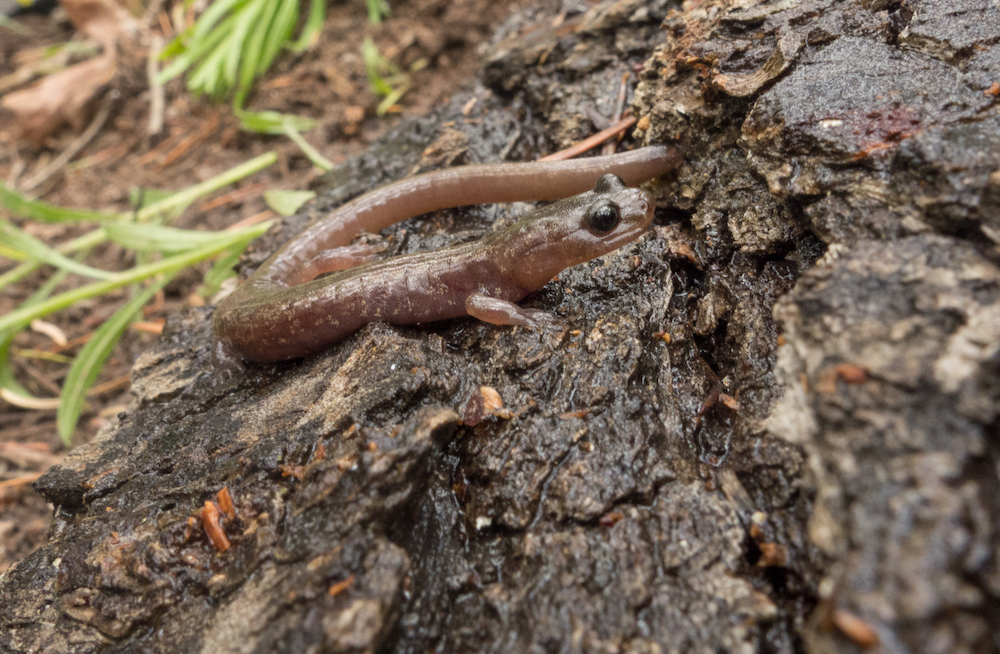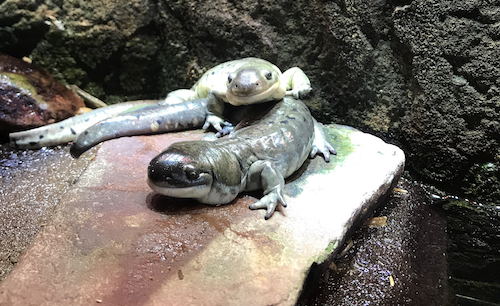
By Chuck Hathcock, Wildlife Biologist at LANL
The Jemez Mountains are home to one of the nation’s most unique salamanders. Only here, and nowhere else in the world, exists the Jemez Mountains salamander (Plethodon neomexicanus). This endemic species is very secretive and not many people have ever seen one. They are thin, about as wide as a pencil, and only large adults are as long as a pencil. They are dark brown above, sometimes with a fine gold stippling of color.

The only other salamander that lives in the area is the tiger salamander (Ambystoma tigrinum) which is very common. They are large and black with distinct yellow stripes or spots. Their aquatic form can be often seen at the Los Alamos Reservoir overflow.
Jemez Mountains salamanders are lungless salamanders, so they “breathe” from gas exchange through their inner mouth linings and their skin. The skin and mouth linings must be moist for gas exchange to occur, so they need a moist environment that does not dry out. That really limits where they can live. They cannot survive in White Rock Canyon, for example.
You may be thinking that the Rio Grande is suitable, but another unusual trait about these salamanders is that they are terrestrial their whole lives, from hatching to adult. They do not have an aquatic larval phase like most other amphibians and when placed in water, the Jemez Mountains salamander will not survive. Because of these limitations, they are only found in certain parts of the Jemez Mountains, usually between 2,200 and 2,900 meters (about 7,200 – 9,500 feet) in elevation. There are known populations within Los Alamos County, even within the Laboratory and townsite boundaries. These lower elevation populations live in small habitat niches that are still moist.
Jemez Mountains salamanders spend the majority of their lives underground. They cannot dig on their own, so they move through the underground world following existing interstitial spaces between fractured rocks or spaces along roots. During the wet and warm monsoon season, they come to the surface and live in rotten logs or under rocks where they can maintain their moist skin. It’s no wonder why they are so hard to find! There are a lot of unknowns about this salamander and the scientific community has many knowledge gaps to fill. How deep underground do they live? What does a nest look like? What drives their underground habitat needs? These and many other questions need to be answered.
All of the things that make the Jemez Mountains salamander so unique and interesting, also make it vulnerable to many threats. One of their biggest threats is stand-replacing wildfires. When a forest is removed by a large wildfire, the ground becomes desiccated. The increased erosion after a wildfire fills all of the spaces in the earth with sediment. Jemez Mountains salamanders in these areas will die off and cannot be replaced.
Because of the many large wildfires in the Jemez Mountains over the last twenty years, the salamander was listed as “endangered” under the Endangered Species Act in 2013. This salamander is at high risk of going extinct and researchers and land managers are doing what they can to avoid their extinction.
If you ever are lucky enough to see a Jemez Mountains salamander, please don’t touch it, but do take a photo and send the photo and location to someone at the Pajarito Environmental Education Center. The data can be passed along to the land managers and federal regulators to help conserve this most unique species that is found nowhere else in the world.
